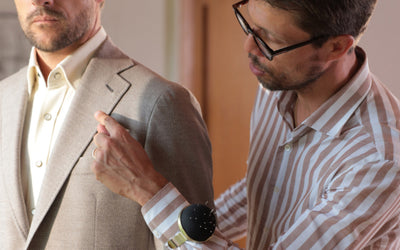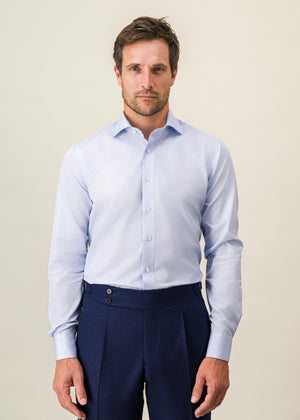Our shirt fabrics
Share
POPLIN
Poplin appears at 15th century , in France. Its current name comes from "papeline", in reference to the papal city of Avignon.
It was made there from silk and wool , and used for cover the furniture .
THE The weft thread, thick, was made of wool, the warp thread of silk : twice as much silk that wool was used for make this fabric .
This historical originality has been preserved in the current manufacturing process .
Nowadays, a weft thread more thick is associated with fine warp threads and twice as many.
This gives the density and of the durability to the fabric .
In appearance smooth , a white poplin shirt can for example be associated with a navy blue worsted wool suit and a bottle green silk tie for a business launch.
A blue shirt would pair very well with a medium gray suit and a purple tie.
In a casual outfit, a poplin shirt may seem precious. We therefore recommend wearing it with an elegant outfit: merino wool cardigan, chinos and loafers will be perfect.
NOTE: Fil-à-fil is a poplin with threads of alternating colors.
THE OXFORD
The Oxford is a very popular shirting fabric, and it is among the most versatile . It is named after the city of Oxford, England, where it was developed by a Flemish weaver in the 17th century.
His armor consists of a doubled warp thread and a single weft thread large circumference. The warp threads are generally colored while the weft threads are white, which creates a subtle “faux uni” effect.
The Oxford is characterized by a fresh and brittle hand , a certain rigidity in the fall and one good support ( crumples little ).
Thanks to his finely checkered appearance , oxford is an excellent balance between texture and refinement .
It can be worn in any circumstance.
A formal attire could therefore combine a pale pink oxford shirt, a mid-grey suit and a plain, navy or purple tie.
In his casual version , the oxford fits perfectly into a preppy-inspired outfit : blue button-down shirt, cream chinos and white bucks with brick soles.
THE CHAMBRAY
THE chambray is a fabric that appeared in Cambrai, in France , at 17th century .
It belongs to the family of batistes , a weaving technique for creating a finer linen canvas developed in the 13th century by Baptiste Cambrai. This fabric was then calendered , that is to say passed between two rolls to give him a icy surface .
Later, chambray was exported , so that its current version comes from UNITED STATES and dates from the beginning of the 19th century. Chambray is formed of a indigo colored warp thread and a white weft thread .
It differs from denim because as a plain weave: it has neither right nor wrong side .
Its properties are a great lightness and one soft fall . Rarely used in business outfits because his raw aspect and his flexibility give an impression of relaxation.
However, know that you can wear it with a beige or light gray suit, and a navy knitted tie.
In a casual style , the only pitfall to avoid would be to wear a shirt in chambray with jeans, their similar colors risk giving the impression of a false plain.
It will therefore be more judicious to associate it with a navy blue honeycomb cardigan , gray wool pants and boots, or brown chinos and a pair of sneakers.
FLAX
Linen fabrics are probably those whose development is the oldest . It is cultivated in Asia for millennia, and has was introduced to Europe 2000 years ago .
It's a plant fiber whose culture requires little water . Egypt old was fond of it , but it is in France that the linen is today mainly cultivated .
Linen thread is obtained from the maceration of the stems directly in the ground , to extract the fibers . These are then raked, spun then woven .
Flax is a light material , with a nervous hand. Excellent thermal regulator , a linen garment East airy but easily marks creases .
Wearing a linen shirt does not mean to be disheveled .
You will need to be careful that the weaving is sufficiently dense , the clean cut even if it is not very fitted, and the collar does not sag .
Few people wear linen to work, but if you choose to do so it is important not to give off a holiday impression : A straight suit with lapels in tip or a cross will allow the outfit to be brought back into a formal context , especially if you opt for a polka dot tie for example.
Otherwise, you can opt for a cotton/linen blend , good compromise between fabric hold and freshness .
Casual material in essence, a linen shirt blue or beige will go perfectly with raw jeans or white pants, and a pair of brown derbies.
THE DOBBY
THE dobby takes its name from the professions that are used to weave it .
They increase or decrease THE number of warp threads and of frame during the weaving to create fine patterns .
This results in finely textured fabrics with a honeycomb appearance .
The dobby is a silky fabric and distinguished by the refinement of its patterns .
THE alveoli present at his surface allow to well reflect light , which is always visually interesting.
A shirt in dobby go then illuminate and reveal the contrasts of your outfit .
A white shirt can be worn as well in evening , with a tuxedo and a silk bow tie ; At work , with a double-breasted flannel suit and a cashmere tie ; or the weekend , with a wool pants .
THE SEERSUCKER
Adopted by the senators of the southern states of the United States from the early 20th century , seersucker is a fabric with rare thermal properties and with a marked visual aspect .
By using, alternately, yarns with different twists , the weaving of seersucker makes alternate smooth strips and embossed strips . So only half of the shirt is in contact with your body!
Fabric resolutely Summery and casual , seersucker is often presented with white and blue stripes .
Scope rolled up sleeves , a striped seersucker shirt is ideal for the weekend .
Preppy look guaranteed :)

THE TWILL
THE twill , or serge, is the characteristic fabric of the process of twill weave .
Her armor , called " with a detachment ", is a structure made of 45° diagonals .
There is the same number of warp and weft threads . The warp shifts by one weft thread in each row , which creates the oblique staircase aspect.
The twill is a soft and lightly textured fabric . Its maintenance is easy, especially during the ironing .
The white twill shirt is part of the Men's wardrobe essentials and will go perfectly with a flannel suit and a shantung silk tie .
This same shirt could also be worn with a big beige wool cardigan, light gray flannel pants and a pair of ankle boots for the weekend .
THE CHEVRON
THE chevron has a fluctuating history depending on the country that claims it.
THE Scottish claim that his square pattern is inspired by fish bones , and they call it herringbone The French gave it the name of parts supporting the roofs .
Regardless, its twill weave creates characteristic zig-zags . This weaving effect is (often) enhanced by the use of warp and weft threads of different colors.
The chevron is characterized in particular by the depth it offers to the colors . In use, it is a soft fabric And easy to iron .
A formal attire could combine a blue shirt, a navy flannel suit and a brown knitted tie.
In a way more casual , you can wear a chevron patterned shirt with a simple raw jeans and a pair of white sneakers.
COTTON FLANNEL
The word flannel comes from Welsh and means " wool " .
Originally all flannel was actually woven in this material , but in recent years we have observed the appearance of cotton flannel or even of cotton/cashmere to properties suitable for a more urban use .
Generally, the wool flannel is built on a plain weave base with carded threads (uncombed, raw) to give it a downy appearance , fell heavy.
Conversely, cotton flannel is usually a serge . The sons are combed and sometimes scraped For amplify the softness of the fabric.
Heavy , flannels benefit from a very nice fall and tend to drape what flatters the figure.
A flannel shirt will have to be associated with “warm” materials in a formal context , such as cashmere, knitted silk, or…flannel!
DENIM
The word " denim " is a contraction of the name " twill canvas from Nîmes ”, historically made in the south of France by the family Andre .
This fabric is originally a wool and silk blend.
There blue of warp thread came from a dyeing called " Genoa blue ", hence the name blue jeans.
THE pigment of this natural dye was obtained thanks to the indigo tree .
Originally, jeans and denim are different !
THE Jeans is a serge whose warp and weft threads are of the same color, while the denim is a serge made of warp threads indigos and weft threads unbleached .
It is this combination that explains the denim fabric wash.
Both fabrics were used for work clothes, the Jeans being the most commonly used canvas by blue collar workers , while the denim was reserved for jobs where friction at the knees in particular was significant , such as miners or mechanics . But in the middle of the 20th century , the appearance of technical fabrics more specialized made this specificity disappear.
Jeans thus became denim pants, and denim also includes denim fabrics under its name . Over time, spinning mills such as Albiate have specialized in the casual fabric work including denim by adopting a high-end approach (high titration, double twist, rare dyes, work on fading, development of special finishes, etc.).
Denim knows today very refined variations . A denim shirt will easily be worn with textured materials. In a formal setting , this shirt must present a smooth appearance And have a fine fabric , otherwise it will look too casual . You can then pair it with flannel and a silk knit tie . A casual outfit would be for example a bee knit cardigan with a beige chinos and sneakers , or a white pants and loafers in a more sprezzatura style .
We have covered around ten of the main shirt fabrics, and the list is not exhaustive!
The fabric is the most visible part of your shirt and deserves really special attention. Faced with so much diversity, we have endeavored to present to you the possibilities of use of each of the fabrics according to the port context.
Now it's up to you to choose the most suitable fabric to your desires and play on contrasts of matter for enrich your outfits!














